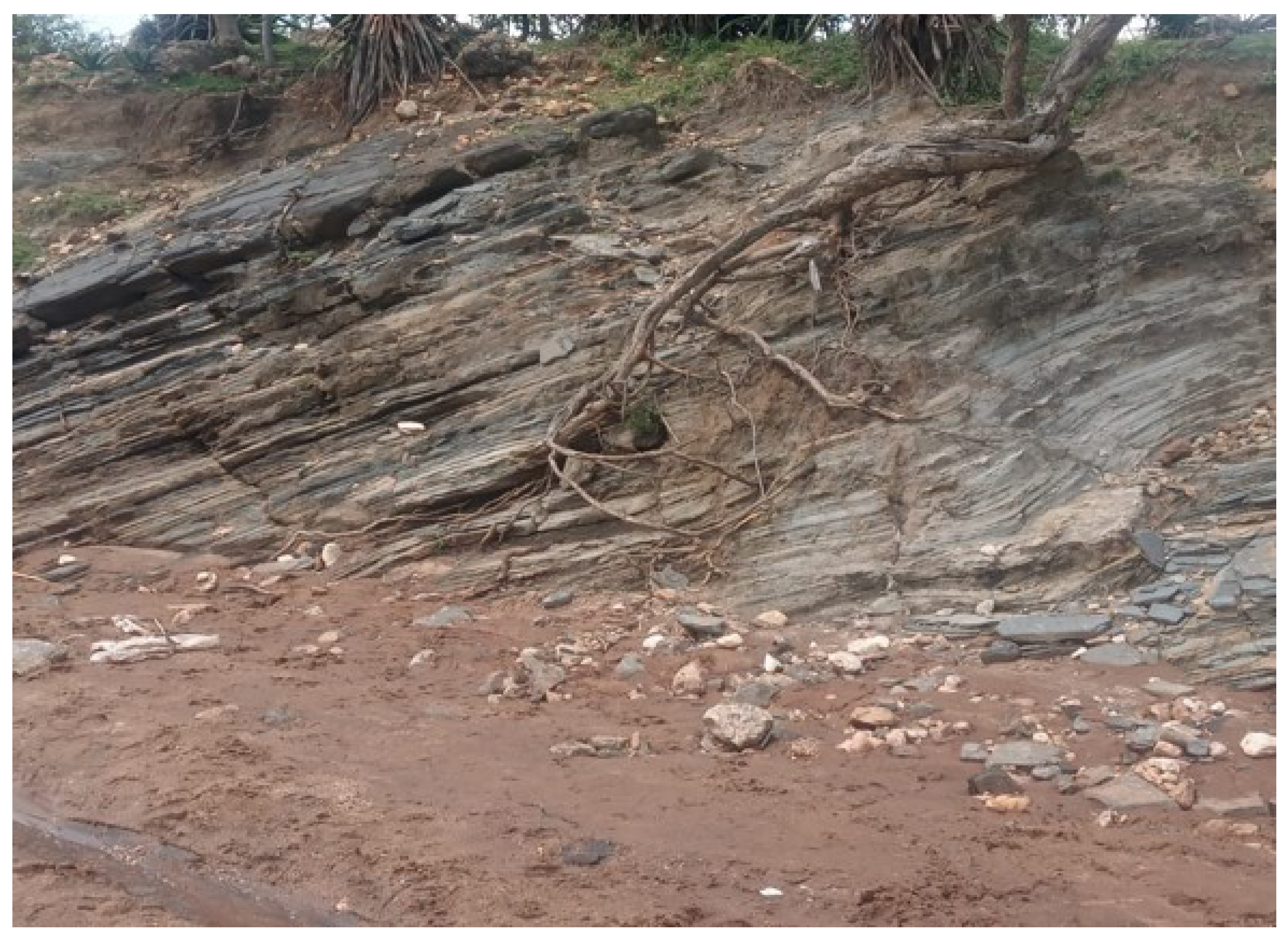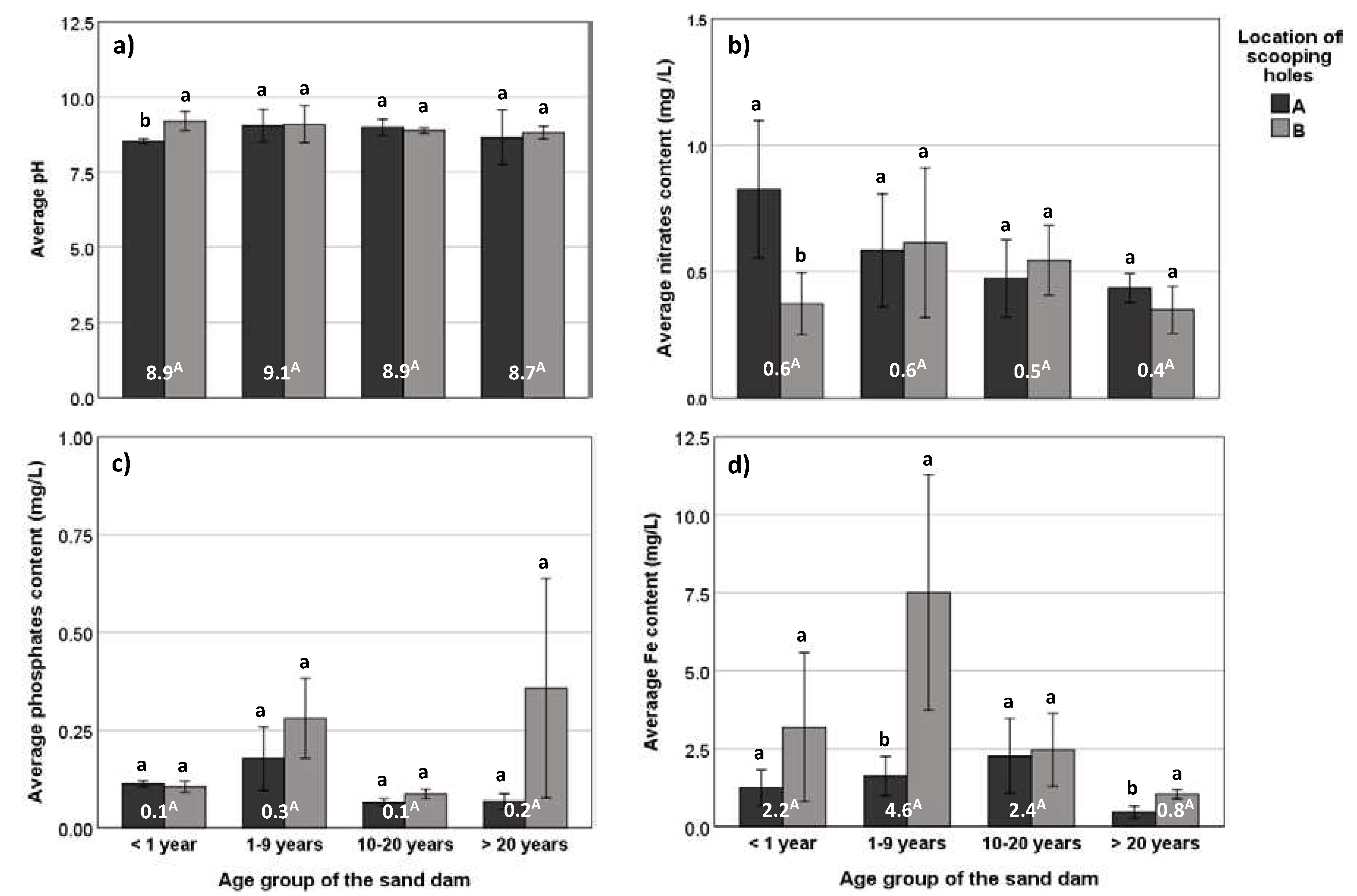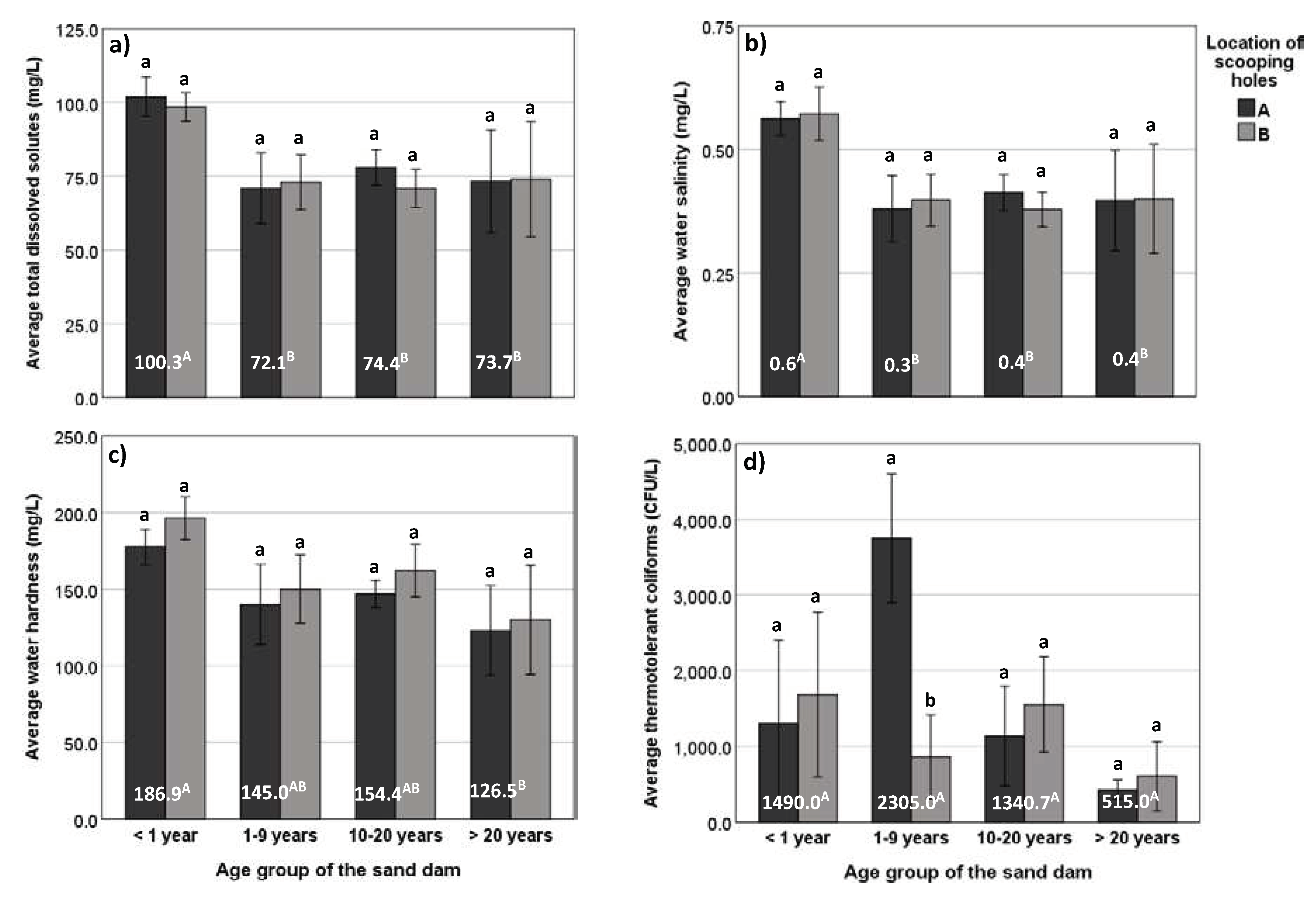Submitted:
30 May 2023
Posted:
01 June 2023
You are already at the latest version
Abstract
Keywords:
1. Introduction
2. Materials and Methods
2.1. Study site description

2.2. Selection of sand dams to be used in the study
2.3. Assessing quality of water abstracted from the scooping holes
2.4. Data analysis
3. Results
3.1. Chemical and microbial properties of water as influenced by sand dam age and location of scooping holes
4. Discussion
4.1. Chemical and microbial properties of water as influenced by sand dam age and location of scooping holes
5. Conclusion
Funding
Acknowledgments
Appendix A
Appendix B
References
- Kumar S, Kumar N, Vivekadhish S (2016) Millennium development goals (MDGS) to sustainable development goals (SDGS): Addressing unfinished agenda and strengthening sustainable development and partnership. Indian J Community Med 41:1–4. [CrossRef]
- 2. Nyagwencha, J.M.; Kaluli, J.W.; Home, P.G.; Hunja, M. (2015) Water and water-borne diseases in North Masaba District, kenya. J Agric Sci Technol 2015, 14, 114–127. [Google Scholar]
- Cissé G (2019) Food-borne and water-borne diseases under climate change in low- and middle-income countries: Further efforts needed for reducing environmental health exposure risks. Acta Trop 194:181–188. [CrossRef]
- Chakraborty, R.; Khan, K.M.; Dibaba, D.T.; et al. Health implications of drinking water salinity in coastal areas of Bangladesh. Int J Environ Res Public Health 2019, 16, 1–10. [Google Scholar] [CrossRef]
- WHO. Guidelines for drinking-water quality, 4th ed.; 2017. [Google Scholar]
- Emadodin I, Reinsch T, Taube F (2019) Drought and desertification in Iran. Hydrology 6:. [CrossRef]
- Kalele DN, Ogara WO, Oludhe C, Onono JO (2021) Climate change impacts and relevance of smallholder farmers’ response in arid and semi-arid lands in Kenya. Sci African 12:e00814. [CrossRef]
- Rentier ES, Cammeraat LH (2022) The environmental impacts of river sand mining. Sci Total Environ 838:155877. [CrossRef]
- Karienye D, Macharia J (2021) African Handbook of Climate Change Adaptation. African Handb Clim Chang Adapt 49–60. [CrossRef]
- UNICEF (2022) Water Scarcity. 2022. Available online: https://www.unicef.org/wash/water-scarcity/ (accessed on 9 April 2022).
- Neufeld DG, Muli J, Muendo B, Kanyari J (2021) Assessment of water presence and use at sand dams in Kenya. J Arid Environ 188:104472. [CrossRef]
- Ritchie H, Eisma JA, Parker A (2021) Sand Dams as a Potential Solution to Rural Water Security in Drylands: Existing Research and Future Opportunities. Front Water 3:1–18. [CrossRef]
- Ryan C, Elsner P (2016) The potential for sand dams to increase the adaptive capacity of East African drylands to climate change. Reg Environ Chang 16:2087–2096. [CrossRef]
- Maddrell SR (2018) Sand Dams : A Practical & Technical Manual.
- Quinn R, Avis O, Decker M, et al (2018) An assessment of the microbiological water quality of sand dams in southeastern Kenya. Water (Switzerland) 10:1–14. [CrossRef]
- Neufeld DG, Muendo B, Muli J, Kanyari J (2020) Coliform bacteria and salt content as drinking water challenges at sand dams in Kenya. J Water Health 18:602–612. [CrossRef]
- Kitheka, J.U. () Seasonal river channel water exchange and implications on salinity levels in sand dams: Case of semi-arid Kitui Region, Kenya. J Environ Earth Sci 2016, 6, 66–85. [Google Scholar]
- Ndekezi M, James WK, Patrick GH (2019) Evaluation of sand-dam water quality and its suitability for domestic use in arid and semi-arid environments: A case study of Kitui-West Sub-County, Kenya. Int J Water Resour Environ Eng 11:91–111. [CrossRef]
- Ndunge D, Mbuge DO, Omuto CT (2019) Protocol for Evaluating Sand Dam Water Quality in Semi-Arid Areas : A Case Study of Makueni County International organization of Scientific Research. IOSR J Eng wwwiosrjenorg ISSN 09:1–14.
- Yifru BA, Kim MG, Lee JW, et al (2021) Water storage in dry riverbeds of arid and semi-arid regions: Overview, challenges, and prospects of sand dam technology. Sustain 13:1–17. [CrossRef]
- Fadiran AO, Dlamini SC, Mavuso A (2008) A comparative study of the phosphate levels in some surface and ground water bodies of Swaziland. Bull Chem Soc Ethiop 22:197–206. [CrossRef]
- Ward MH, Jones RR, Brender JD, et al (2018) Drinking water nitrate and human health: An updated review. Int J Environ Res Public Health 15:1–31. [CrossRef]
- Seo M, Lee H, Kim Y (2019) Relationship between Coliform bacteria and water quality factors at weir stations in the Nakdong River, South Korea. Water (Switzerland) 11:. [CrossRef]
- Belaud G, Combemale D (2015) Netherlands E-proceedings of the 36. 1–5.
- WHO. Guidelines for drinking quality water, 3rd ed.; WHO: Geneva, 1997. [Google Scholar]
- APHA (1998) Standard methods for the examination of water and wastewater, 20th ed. American water works association and water environmental federation, Washington DC.
- Thomas R, Vaughan I, Lello J (2013) Data Analysis with R Statistical Software. 150.
- Bates D, Mächler M, Bolker BM, Walker SC (2015) Fitting linear mixed-effects models using lme4. J Stat Softw 67:. [CrossRef]
- WHO (2012) Water quality for drinking: WHO guidelines.
- Wurts WA, Durborow RM (1992) Interactions of pH , Carbon Dioxide , Alkalinity and Hardness in Fish Ponds. 0:1–4. 1.
- Okeke, O.; Okogbue, C. Shales: A review of their classifications, properties and importance to the petroleum industry. Glob J Geol Sci 2012, 9, 75–83. [Google Scholar]
- Wynn E, Krieg MA, Aeschlimann JM, Burckhardt P (2009) Alkaline mineral water lowers bone resorption even in calcium sufficiency:. Alkaline mineral water and bone metabolism. Bone 44:120–124. [CrossRef]
- Lytle DA, Schock MR (2008) Pitting corrosion of copper in waters with high pH and low alkalinity. J / Am Water Work Assoc 100:115–129. [CrossRef]
- DeZuane, J. Handbook of drinking water quality, 2nd ed.; John Willey & Sons: New York, 1997. [Google Scholar]
- KEBS (2015) Portable Water - Specifications. Nairobi.
- Addisu S, Mekonnen M (2019) Check dams and storages beyond trapping sediment, carbon sequestration for climate change mitigation, Northwest Ethiopia. Geoenvironmental Disasters 6:2–9. [CrossRef]
- Bacon B, Britton R (1990) SDecial Article The Pathology of Hepatic Iron Overload: A Free Radical -Mediated Process? Hepatology 12–15.
- Abbaspour, N.; Hurrell, R.; Kelishadi, R. Review on iron and its importance for human health. J Res Med Sci 2014, 19, 164–174. [Google Scholar] [PubMed]
- Ngabirano H, Byamugisha D, Ntambi E (2016) Effects of Seasonal Variations in Physical Parameters on Quality of Gravity Flow Water in Kyanamira Sub-County, Kabale District, Uganda. J Water Resour Prot 08:1297–1309. [CrossRef]
- 40. Iqbal, F.; Ali, M.; Salam, A.; Khan, B.A.; Ahmad, S.; Qamar, M.; Umer, K. Seasonal Variations of Physico-Chemical Characteristics of River Soan Water at Dhoak Pathan Bridge (Chakwal), Pakistan. Int J Agric Biol 2004, 6, 89–02. [Google Scholar]
- McCambridge J, McMeekin TA (1980) Relative effects of bacterial and protozoan predators on survival of Escherichia coli in estuarine water samples. Appl Environ Microbiol 40:907–911. [CrossRef]
- Hobley L, Summers JK, Till R, et al (2020) Dual predation by bacteriophage and bdellovibrio bacteriovorus can eradicate escherichia coli prey in situations where single predation cannot. J Bacteriol 202:. [CrossRef]


Disclaimer/Publisher’s Note: The statements, opinions and data contained in all publications are solely those of the individual author(s) and contributor(s) and not of MDPI and/or the editor(s). MDPI and/or the editor(s) disclaim responsibility for any injury to people or property resulting from any ideas, methods, instructions or products referred to in the content. |
© 2023 by the authors. Licensee MDPI, Basel, Switzerland. This article is an open access article distributed under the terms and conditions of the Creative Commons Attribution (CC BY) license (http://creativecommons.org/licenses/by/4.0/).




